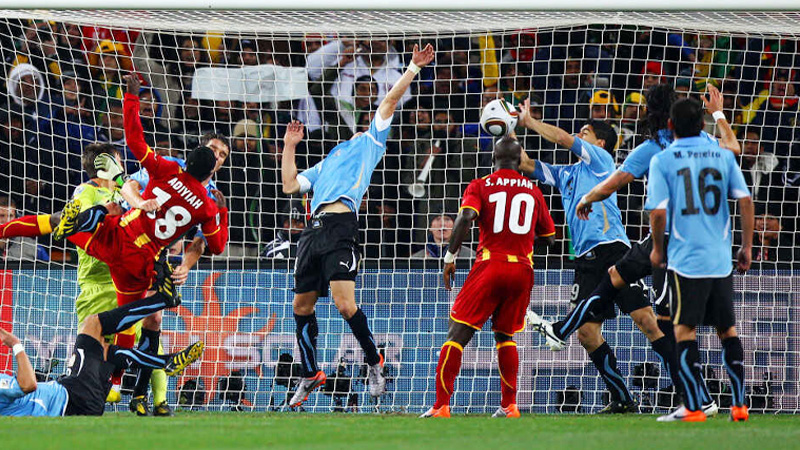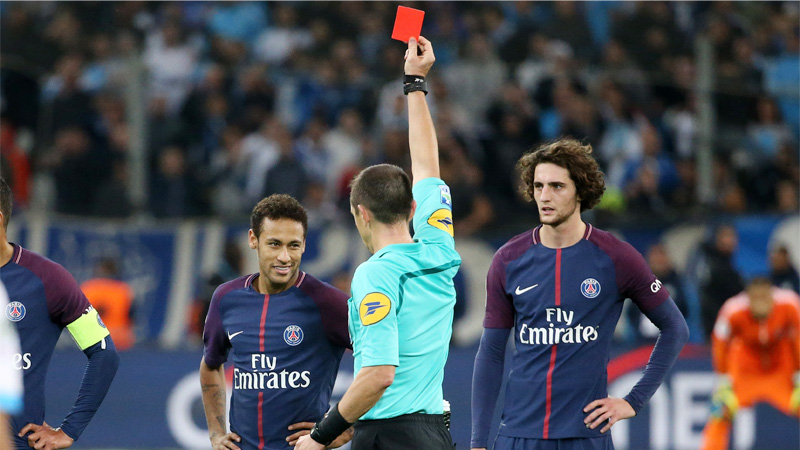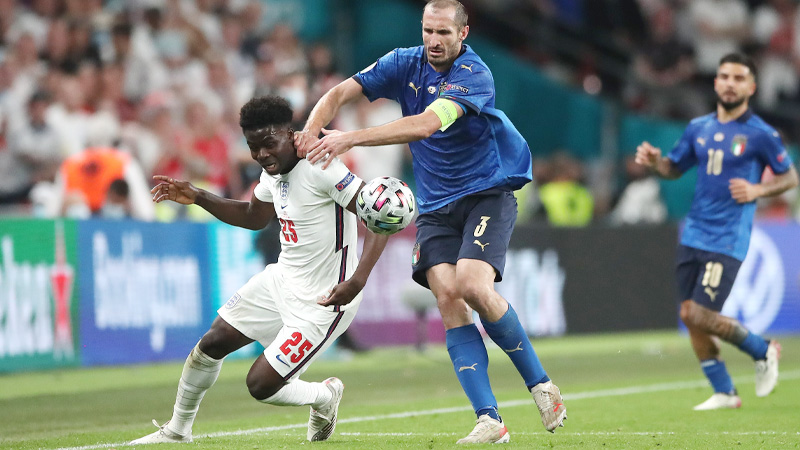In the world of soccer, where skill, strategy, and teamwork reign supreme, there exists a controversial aspect of the game that often sparks heated debates among players, coaches, and fans alike: the tactical foul.
While fouls are generally frowned upon in the sport, the tactical foul is a calculated maneuver employed by players to disrupt the flow of the game, gain a strategic advantage, or prevent an opponent from scoring.
This intriguing tactic involves players deliberately committing fouls, such as tripping, holding, or obstructing opponents, with the intention of breaking up the opposition’s attacking play or halting a counterattack.
Coaches and players often debate the ethics of tactical fouls, as they can be seen as unsportsmanlike behavior. So, in this article, we’ll delve into the world of soccer tactical foul, exploring its legality and related regulations.
Definition of a Soccer Tactical Foul
A soccer tactical foul, also known as a professional foul or a cynical foul, is a deliberate foul committed by a player with the intention of disrupting the opponent’s attacking play or preventing a goal-scoring opportunity. It is often used as a strategic move to gain an advantage for the defending team.
Tactical fouls can occur in various situations on the field. For example, if an attacking player is making a dangerous run toward the goal, a defender might intentionally trip or pull them back to stop their progress.
Similarly, if an opponent is about to launch a counter-attack, a player might commit a tactical foul to break up the play and allow their team to regroup defensively.
The primary purpose of a tactical foul is to disrupt the flow of the game and prevent the opposing team from capitalizing on a scoring opportunity. By committing a foul, the defending team can slow down the game, regain their defensive shape, and potentially avoid conceding a goal.
Is Tactical Fouling Legal in Soccer?
Tactical fouling is not legal in soccer. The Laws of the Game, which govern the sport, state that players must not commit fouls in a manner that is careless, reckless, or uses excessive force.
Tactical fouls, by their nature, involve deliberately breaking the rules to disrupt the opponent’s play or prevent a goal-scoring opportunity.
Referees are responsible for enforcing the rules and penalizing players who commit fouls, including tactical fouls. When a player commits a tactical foul, they may receive a yellow or red card, depending on the severity of the offense.
A yellow card is typically shown for less serious fouls, while a red card is given for more severe or intentional fouls, which can result in the player being sent off the field.
The aim of the rules is to ensure fair play and maintain the integrity of the game. While tactical fouls may be used strategically by players and teams, they are considered unsportsmanlike behavior and are not condoned within the rules of soccer.
Some Famous Tactical Fouls in Football

Source: npr
There have been several famous instances of tactical fouls in football throughout history. Here are a few notable examples:
Luis Suárez – 2010 FIFA World Cup
In a quarter-final match between Uruguay and Ghana, Luis Suárez infamously used his hand to block a goal-bound header from Dominic Adiyiah in the dying moments of the game.
Suárez received a red card for the deliberate handball, but Ghana missed the subsequent penalty kick, and Uruguay eventually won the match in a penalty shootout.
Sergio Ramos – UEFA Champions League Final 2018
In the final between Real Madrid and Liverpool, Sergio Ramos tackled Liverpool’s Mohamed Salah, causing him to leave the field with a shoulder injury.
The foul was seen by many as a deliberate attempt to neutralize Salah’s threat, and it had a significant impact on the outcome of the match, as Real Madrid went on to win 3-1.
David Beckham – 1998 FIFA World Cup
In a round of 16 match between England and Argentina, David Beckham was sent off for kicking out at Argentina’s Diego Simeone.
Beckham’s foul was seen as a retaliatory act after Simeone had fouled him earlier in the game. England eventually lost the match on penalties, and Beckham faced significant backlash from the English media.
Paolo Montero – Serie A
Paolo Montero, an Italian-Argentine defender, was known for his aggressive style of play and tactical fouling. He played for Juventus and was notorious for committing fouls to disrupt the opposition’s attacking play.
Montero’s tactical fouls often drew criticism, but he was also praised for his defensive abilities.
José Luis Chilavert – Copa Libertadores
José Luis Chilavert, a Paraguayan goalkeeper, was known for his skill in goal as well as his aggressive style of play. He was not afraid to commit tactical fouls outside his penalty area to disrupt the opposition’s attacks.
Chilavert’s fouls often drew attention and controversy, but he was also admired for his leadership and goal-scoring ability as a goalkeeper.
These are just a few examples of famous tactical fouls in football. While some of these incidents were met with criticism, they highlight the strategic aspect of the game and the lengths players sometimes go to gain an advantage.
Consequences of Tactical Fouling

Source: ESPNFC
Tactical fouling in soccer can have several consequences for both the player committing the foul and their team. Here are some of the potential outcomes:
Yellow or Red Card
Depending on the severity of the foul, the player may receive a yellow or red card from the referee. A yellow card serves as a warning, while a red card results in the player being sent off the field. Accumulating multiple yellow cards or receiving a straight red card can lead to suspensions for future matches.
Free Kick or Penalty Kick
When a tactical foul is committed, the opposing team is usually awarded a free kick or penalty kick, depending on the location of the foul. This can provide the opposing team with a scoring opportunity and put the defending team at a disadvantage.
Momentum Shift
Committing a tactical foul can disrupt the flow of the game and shift the momentum in favor of the opposing team. It can break up attacking plays, frustrate the opposition, and give them a chance to regroup and reorganize defensively.
Strategic Disadvantage
While tactical fouls are sometimes used as a strategic move, they can also backfire. If a player commits a foul in a dangerous area, it can result in a direct free kick or penalty kick, which increases the likelihood of the opposing team scoring.
Reputation and Public Perception
Players who frequently engage in tactical fouling may develop a reputation for unsportsmanlike behavior. This can lead to negative public perception and affect their standing within the soccer community.
It’s important to note that the consequences of tactical fouling can vary depending on the specific circumstances and the referee’s interpretation of the foul. Referees have the discretion to determine the severity of the offense and apply the appropriate disciplinary measures.
FAQs
Why do players commit tactical fouls?
Players commit tactical fouls to gain a strategic advantage by breaking up the opponent’s momentum or preventing a dangerous attack. It can help buy time for their team to regroup defensively.
How do referees identify tactical fouls?
Referees look for certain indicators, such as the timing and location of the foul, the player’s intent, and the impact on the opponent’s attacking play. They use their judgment to determine if a foul was committed tactically.
Are tactical fouls considered unsportsmanlike behavior?
Tactical fouls are generally seen as unsportsmanlike behavior because they go against the spirit of fair play. However, they are a common tactic used by teams to gain an advantage in competitive matches.
Are tactical fouls more common in professional soccer?
Tactical fouls are more prevalent in professional soccer due to the higher stakes and increased competitiveness. Players and teams often employ tactical fouls as a strategic tool to disrupt the flow of the game.
Can a tactical foul result in a player being sent off?
Yes, a tactical foul can result in a player being sent off if it is deemed a serious foul play or if the player receives a second yellow card.
Signing Off!
As the final whistle blows, the debate surrounding soccer tactical fouls continues to rage on. While some argue that it is an essential part of the game, allowing teams to gain an advantage and disrupt their opponents’ rhythm, others believe it goes against the spirit of fair play and sportsmanship.
Regardless of where one stands on the issue, there is no denying the impact that tactical fouls have on the dynamics of a match. They can change the course of a game, frustrate opponents, and test the referee’s ability to maintain control.
As soccer evolves and tactics become more sophisticated, the question of how to address tactical fouls remains a challenge for the sport’s governing bodies. Striking the right balance between allowing strategic disruption and preserving the integrity of the game is a delicate task.







